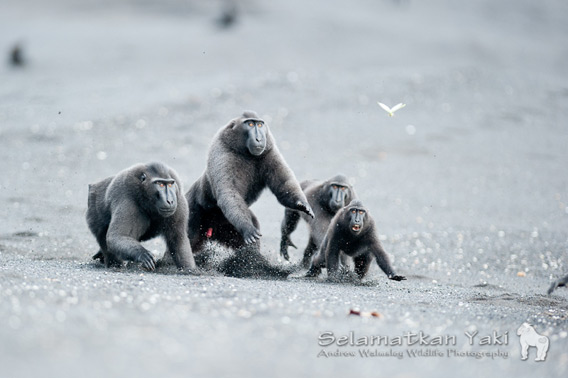
Social ties are incredibly important for all primate species, forming close affiliations for support. Photo © Andew Walmsley Wildlife Photography
North Sulawesi is one of the world’s most beautiful places. Verdant forests and stunning coral reefs, combined with high levels of species endemism, make it a top biodiversity hotspot.
But pressure on the region’s natural resources is mounting. Mining projects, conversion of forests for plantations, overfishing, and the expansion of a commercial bushmeat trade is endangering some of Sulawesi’s most charismatic animals, including the distinctive Sulawesi crested black macaque.
Found only in North Sulawesi, the crested black macaque could be one of Indonesia’s most iconic conservation symbols, but relatively few people know of its existence. And the locals who do may be inclined to eat it as a delicacy.
Working to change that is Selamatkan Yaki, a conservation initiative that aims to protect the Sulawesi crested black macaque and its forest habitat by raising awareness of its plight, highlighting the benefits brought by conservation, and attempting to make the macaque more valuable in the wild, by encouraging tourism, than on someone’s dinner plate.
During a June 2012 interview with mongabay.com, Harry Hilser, Selamatkan Yaki Field Project Manager, discussed his group’s efforts to save the Sulawesi crested black macaque.
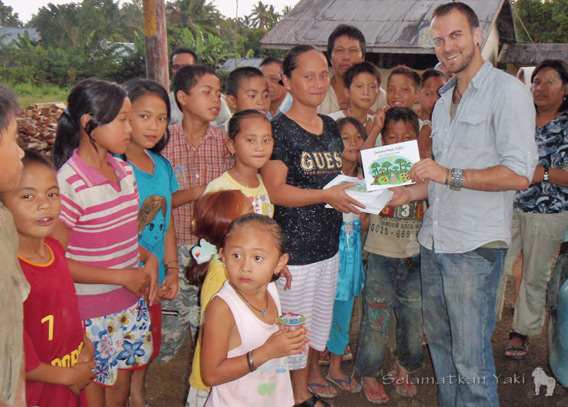
Harry Hilser: “Facilitating education and raising awareness can help empower the next generations to reduce our impacts on the environment.”
mongabay.com: What is your background and why did you choose the Sulawesi crested black macaque?
Harry Hilser: Indonesia has a unique allure, one that has enticed me to continue working here for several years. My first visit to this distinctive archipelago was on a traveling excursion that saw me captivated by the array of sights, smells and sounds. Academic research invoked a deeper insight into the environmental volatility here…the effects of widespread deforestation and species endangerment, leading me to pursue a career in conservation. Aside from the incessant smiles and warm welcomes from the local people, it is the great diversity of life found in Indonesia’s forests and seas that I am most connected to. Sulawesi, the largest island in the Wallacea biodiversity hotspot, has the greatest endemism in Indonesia and it is estimated that 25% of its bird species and 62% of its mammal species are unique to the island. If we exclude bats, it’s a massive 98% of mammals!
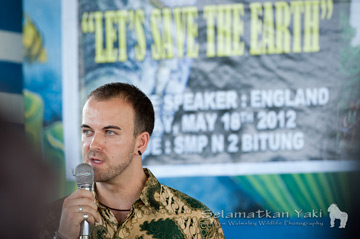 Harry Hilser: “An explicit realization must be sought that we are attempting to protect yaki’s forest homes; if we protect the forests we safeguard a multitude of other species, including people.” |
Amongst this wealth of biological diversity resides a rather special yet little-known primate species. The charismatic Sulawesi crested black macaque (Macaca nigra) is one of seven macaque species found only on Sulawesi, endemic to the Eastern tip of Sulawesi’s Northern peninsula. Restricted to small forest fragments they are characterized by their distinctive crest of hair, entirely black face and body coloration; with their bright pink, heart shaped bottom pads (‘ischial callosities’) these monkeys are a striking and iconic species.
Despite their charismatic charm, they are unfortunately amongst the many highly endangered mammal species in South East Asia. In 2008 their IUCN red list status was raised from Endangered to Critically Endangered to reflect a worrying decline in numbers with estimates as high as 90% in the last 30 years. Selamatkan Yaki (‘Save Sulawesi crested black macaques’) is a conservation program that aims to protect the macaques and their forest habitat, supported by Whitley Wildlife Conservation Trust in the UK and a strong collaborative network of partners. I am currently the Field Project Manager situated in North Sulawesi and as such I am responsible for organizing and rolling out projects to meet our conservation objectives.
mongabay.com: What are the biggest threats to Sulawesi crested black macaques? Is poaching for local or commercial consumption?
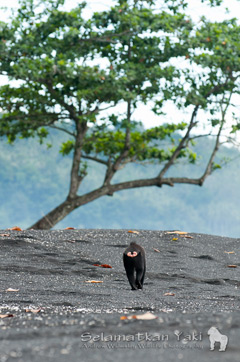 With dramatic population declines in recent years these majestic monkeys are in urgent need of protection. Photo © Andew Walmsley Wildlife Photography |
Harry Hilser: Aside from extensive habitat loss within an already restricted range, the crested macaques face a more unusual yet devastating threat to the survival of the species. The consumption of bushmeat in Minahasa is a tradition that has grown in parallel to human population expansion, and has thus been identified as the primary threat to the species’ survival.
North Sulawesi is a well-developed and relatively affluent province of Indonesia. High levels of protein and caloric intake, education and literacy mean that the people here are neither nutritionally nor economically dependent on wild meat. Poaching tends to fuel a commercial market, with large quantities of protected animal bushmeat distributed across the province. Markets supply meat to a large number of traditional restaurants in the region and there is evidence of seasonality in the trade activity of protected animals, where increases in sales around festive periods have been noted. Monkey meat, in addition to its status as a delicacy is considered to be medicinal with healing qualities such as curing skin diseases or enhancing strength. The predominantly Christian population in Minahasa lack religious constraints over wildlife consumption as in other regions of Indonesia, and monkey is considered a delicacy with a majority of hunting meeting demands as ceremonial food rather than for subsistence. Hunting rates have been demonstrated to be highly unsustainable, which has led to local extirpation of other species throughout Minahasa highlighting the strong requirement for immediate conservation action.
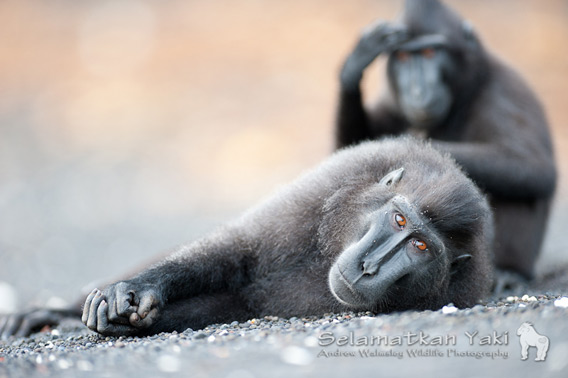
Grooming is a favorite pastime in monkey societies; it can act to reinforce bonds and reduce tension within the group. Photo © Andew Walmsley Wildlife Photography
mongabay.com: North Sulawesi is a region of stunning natural beauty. Do you see much potential for ecotourism/responsible nature tourism to create economic incentives for protecting Sulawesi crested black macaques?
Harry Hilser: Although there are various definitions, we believe ecotourism should be a sustainable tourist experience, with focus on reducing environmental impact whilst also considering cultural understanding and appreciation through conservation and sustainable development. The achievement of these goals depends on a complexity of factors led by political, economic and social decisions that govern the implementation of tourist attractions and their management. Tourism has many caveats and challenges with regards to deriving a net overall social, economic and environmental gain and requires multi-stakeholder cooperation. Recent years have seen a rapid expansion of tourism in the region, yet so far reserves do not generate enough money to implement sufficient management, resulting in negative effects on primate behavior whilst losing out on potential local benefits.
It is recognized that if managed well, ecotourism has the potential to bring local economic benefits and national revenue, facilitating development with infrastructure and communication improvements, whilst raising awareness about environmental issues and creating pride in wildlife and natural areas. Furthermore, successful ecotourism can support biodiversity conservation by influencing national policy complementing our other activities such as increasing effectiveness of protection in protected areas, culminating in greater success of preserving the remaining populations of Sulawesi crested black macaques. North Sulawesi’s natural beauty brings in high levels of tourism activity, so preserving its endemic species and unique status is a substantial incentive for national economic development.
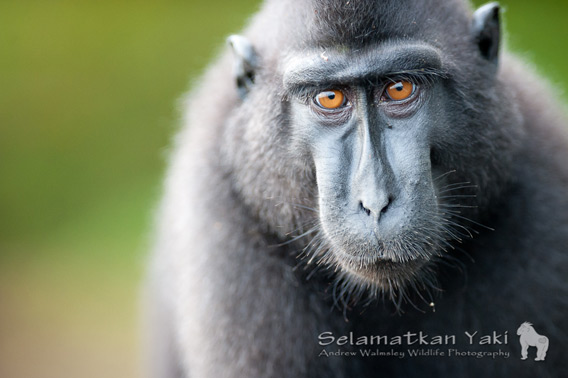
Sulawesi crested black macaques – a striking and iconic species. Photo © Andew Walmsley Wildlife Photography
mongabay.com: What are your other approaches beyond ecotourism?
Harry Hilser: In order to ensure the survival of the macaques, we have developed an integrated approach to addressing the threats which are currently endangering the species. In the long-term we hope to facilitate enhanced enforcement and protection of reserves, whilst maintaining support from local communities.
We have established a collaborative team which represent the main stakeholders working in this region. A Species Action Plan is currently in development in order to support our strategy as a foundation for future conservation activities. By working strategically evaluating current protection activities, supporting patrols, facilitating local and regional dialogue and monitoring illegal activities it is proposed that the management of protected areas can be brought to a higher standard.
One fundamental aspect of our conservation activities is education and awareness-raising. Environmental education holds powerful potential to increase knowledge (of macaques, their conservation status, the threats endangering them and alternative actions which could be carried out to mitigate these threats) and a positive attitude and empathy towards conservation. A clear association between knowledge and attitudes, and the resultant behavior and level of support for conservation motivates the requirement for education and awareness-raising activities not only here in Indonesia but around the world. With a wealth of other species dependent on the same habitat, including people, protecting the forests will ensure the survival of the impressive biodiversity of this unique area.
mongabay.com: What can people in the U.S. and other parts of the world do to help?
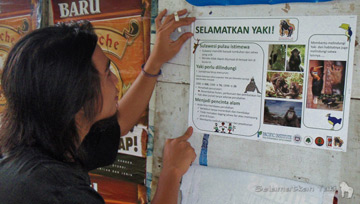 Education materials including books, posters and presentations are measurable ways to increase knowledge about the threats to a species and potential ways to mitigate the threats.  Active involvement by school groups and community members can enable a deeper connection to the natural environment and help develop support for conservation efforts. Photos © Harry Hilser/Selamatkan Yaki |
Harry Hilser: I am a firm believer in the power of connectivity and global collaboration to bring about positive change to lower our impacts, and I hold a lot of hope for the future of our planet. Support can be given by helping to spread a wave of awareness of conservation issues and the work being done on the ground. Whether it is through signing petitions, supporting campaigns or boycotting unethical or destructive companies, a general perspective of sustainability will go a long way. Donations are always welcome and even small funds can go a long way in supporting small conservation programs.
Despite the escalating deforestation crisis and continual news of threatened species, I feel there is a lot to be positive about. Conservation works (e.g. Hoffman et al and Sodhi et al) and there are many people who have come together and achieved a great deal, positively impacting many of the world’s endangered species.
I urge people to visit our website and spread the conservation message, whilst actively pursuing ways to reduce your own environmental impacts and rates of consumption, subsequently lowering pressures on resource extraction and helping to secure the survival of the world’s precious ecosystems.
selamatkanyaki.com
wwct.org.uk
Related articles
Distressed Place and Faded Grace in North Sulawesi
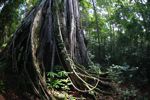
(05/10/2011) The Nantu Wildlife Reserve is located in northern Sulawesi’s Minehasa Peninsula, in Gorontalo Province. Sulawesi is among the largest of Indonesia’s some seventeen thousand islands. Its shape is bizarre: a sinuous sprawling monkey, with lavish tail, poised to leap the straits of Makassar. Sulawesi lies to the north of Bali and Lombok and to the east of Borneo. Alfred Russell Wallace, the nineteenth century English explorer and natural scientist of broad expertise, spent a lot of time in Sulawesi’s northern peninsula, casting his curiosity and observation with such singular acuity that his mind apprehended “Darwin’s theory of evolution” independently from and possibly before Darwin. His work described the zone of transition between the Asian and Australian zoographic regions and was so accurate and thorough in its logic that today, some one-hundred and fifty years later, the zone is named Wallacea.
Sulawesi groups recognized for efforts to save endangered wildlife, forests
(12/08/2010) Two groups working with local communities to conserve forests in Sulawesi have won mongabay.com’s 2010 Conservation Award. The Alliance for Tompotika Conservation (AlTo), which works in Central Sulawesi, and the Nantu Forest Conservation Program, which operates in North Sulawesi, were recognized for their efforts to protect endangered forests on the Indonesian island, which is known for its high levels of endemic species.
Saving the maleo, a geothermal nesting bird, in Sulawesi
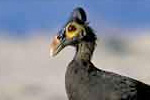
(12/06/2010) More species are threatened with extinction in Indonesia than any other country on Earth. If we are to save them, it will take more protected areas, radical shifts in deforestation, and better anti-poaching efforts, but in many cases it will also take species-specific conservation efforts that work directly with local people. The Alliance for Tompotika Conservation (AlTo) is a model organization for this method, founder Marcy Summers describes it as ‘very small, community-based, and efficient, with very low overhead.’ By focusing on the wonderfully bizarre maleo, a ground-dwelling bird on the island of Sulawesi, the organization has succeeded in protecting a vital nesting area while initiating a moratorium on the egg-harvesting, which once devastated the species.
Saving Sulawesi’s ‘pig-deer’, the babirusa
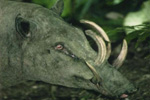
(12/06/2010) The babirusa of Sulawesi may be one of the world’s oddest looking—and acting—mammals. Literally meaning ‘pig-deer’ the babirusa, which includes four species, belongs to its own genus ‘Babyrousa’ in the pig family. Males are especially unique, sporting four tusks, two of which appear to come right out of the animal’s snout. To make it to the top of the babirusa hierarchy, males will combat each other in an activity dubbed ‘boxing’ where they will rear up on their hind legs and club at each other. Despite their many oddities, the babriusa were not formally studied until the late 1980s when Dr. Lynn Clayton spent four years in Sulawesi’s forest observing them.